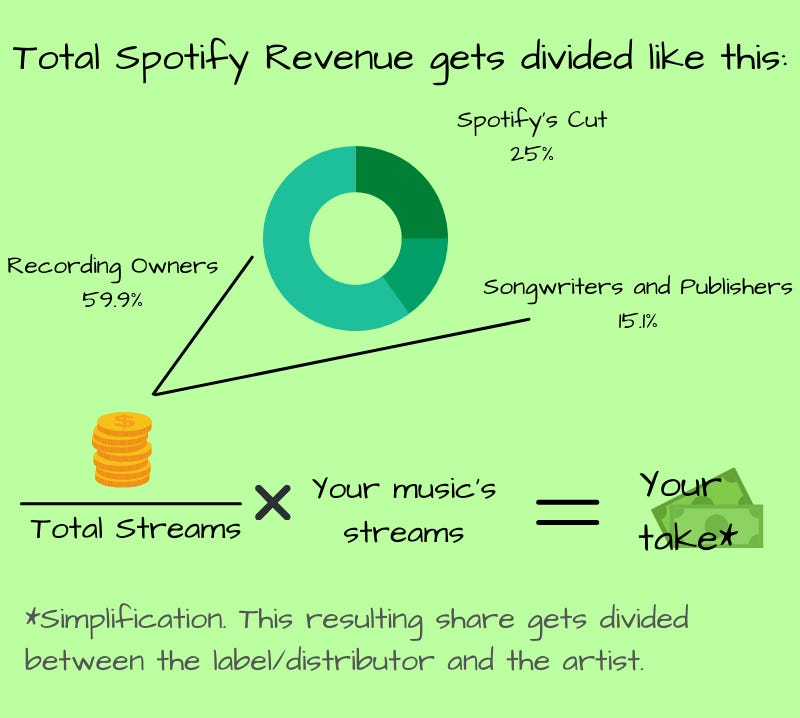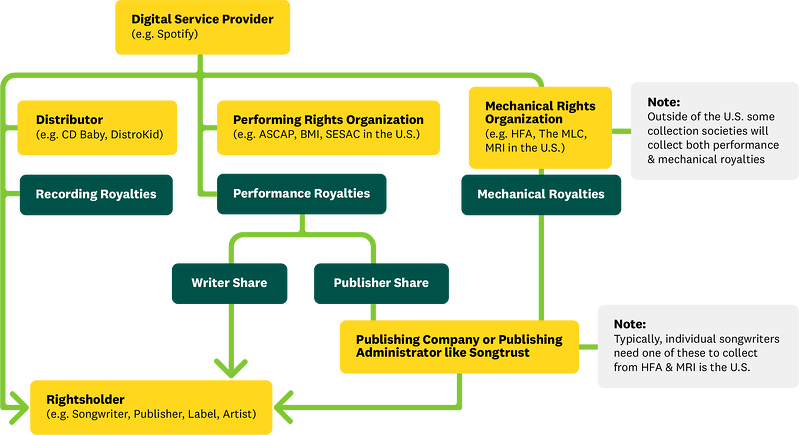[2023] How royalties and money flow in digital streaming for independent music artists
Last updated: Jan 2023
Disclaimer: I may oversimplify some concepts, but will try my best to condense the mess of the music industry into one article. Oh, and it’s also highly tailored to the US market
Part 1: An introduction to how digital music revenue works
Key Terminology (Do not skip this)
In order to understand the nuances between the different distributors, it’s important to understand how streaming and digital revenue works. To start, here are some key terminology to clarify:
Composition: The actual melody and lyrics. This usually involves a mix of songwriters, performers, and vocalists (or they can all be one person!)
Recording (Also known as Master): The digital file of the song that can be played
Publisher: The company, or person, who is promoting the song and monetizing it to generate revenue. This could be a record label, or the songwriters themselves!
DSP: Digital Service Provider, also known as a streaming service or store (e.g. Spotify, Apple Music, Bandcamp)
Distributor: This is a service which helps the publisher get their song onto many of the different streaming platforms, and collects the revenue from them.
Royalties: A payment owed to whomever owns the right to a specific asset. For the purposes of this article, we’re only to cover mechanical rights and performance rights. For a full explanation on copyright and royalties, check out this fantastic article by RoyaltyExchange.
Mechanical Royalties: This is a concept that was passed down into streaming back when most music revenue was from the sale of CDs. Each time a CD was duplicated and sold, labels needed to pay the songwriters a royalty. For streaming, the duplication is ‘on-demand’ for each stream, and is still collected to be paid out. This rate is set by the government.
Performance Royalties: These royalties are owed whenever a song is played in public, whether it’s at a bar, in the airplane, the radio, or even when it’s streamed on Spotify or Apple Music.
Performing Rights Organization (PRO)/Mechanical Rights Organization (MRO): Government designated organizations that collect mechanical and performance royalties
Publishing Representative: An agency that collects global mechanical and performance royalties for the song.
How royalties are split from each stream
Each time a song is streamed on a DSP, the money is split into three parts. For this explanation, we’ll use Spotify and fictional numbers (which are roughly what the market is):
Spotify collects 25% of the revenue a stream generates for themselves. This specific percentage is negotiated between DSPs and distributors, which means not all distributors have equal payouts. Some distributors may pay more for certain regions, or certain DSPs than others.
60% then goes to the sound recording royalty owner, which is collected by the distributor
The remaining 15% goes to the individual government-designated agencies that collect the performance and mechanical royalties. Typically the composition owner/songwriter and publisher split this royalty 50/50.
The graphic below per HypeBot demonstrates this split:
[IMPORTANT]: You need to register for publishing!
The significance of collecting mechanical and performance royalties: 20% of an artist’s revenue
Many independent artists may not be collecting the performance and mechanical royalties, which amounts to 20%+ of their streaming income. This is assuming the artist is the one publishing their own music, and thus collects both the songwriter and the publisher halves of the royalties. To do this, the artist must register for a PRO.
Within the United States, artist can register for BMI for free to collect the songwriter and publisher parts of the performance royalty.
They then will need to register with The Mechanical Licensing Collective to collect the mechanical royalties.
However, to collect international royalties, they would then need to register with each individual country, which could be a significant hassle. The solution is to find a publishing representative that can collect it for you, such as CD Baby Pro Publishing, Songtrust, etc. who usually collect a commission of 9-15% of the royalties collected.
These agencies are unable to collect the songwriter’s share of the performance royalty in the United States, so artists will still need to register with a PRO.
tl;dr
Each time your song is streamed, the DSP collects a percentage of the revenue, which differs between distributors. Of the remaining revenue, 80% goes to your distributor for the recording royalty to be paid out to you, 20% needs to be collected by the artist themselves through PROs & MROs, or through a publishing representative.
Below is a graphical representation courtesy of Songtrust



